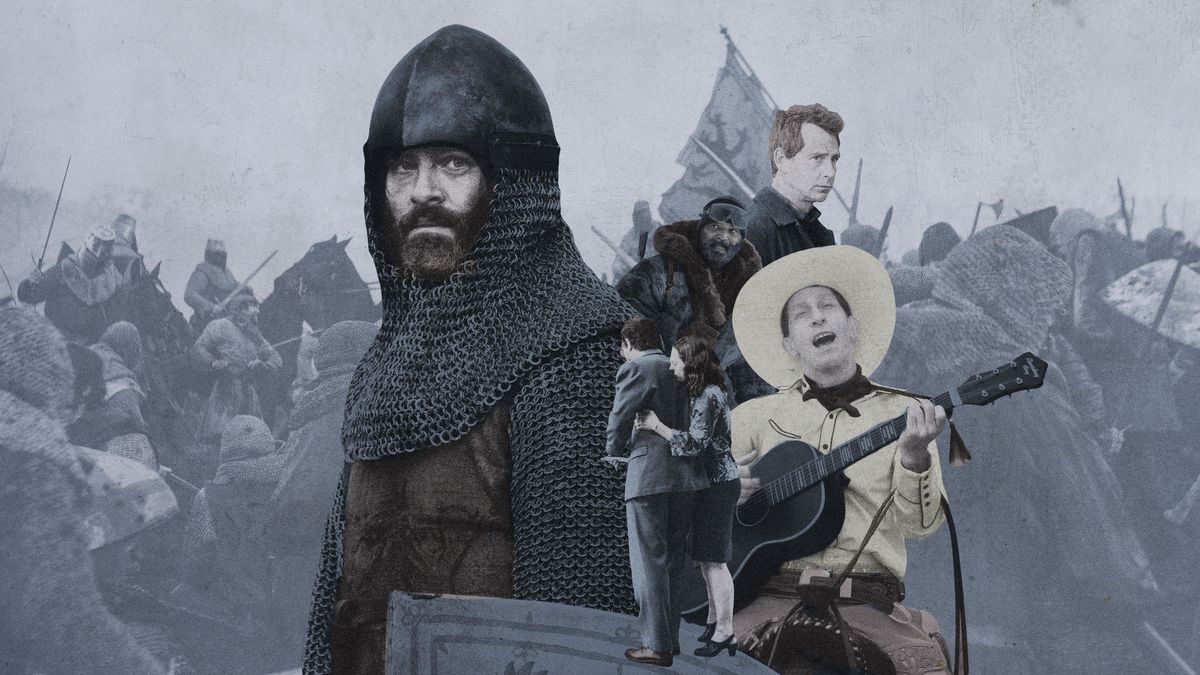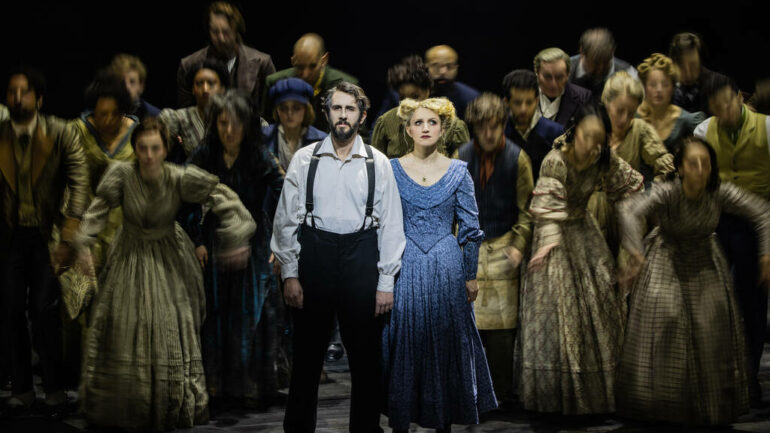chevron_left
-
play_arrow
NGradio So good... like you
Now Netflix Wants to Conquer Prestige Movies—and the Oscars. Why

The streaming service’s latest original film, the historical epic ‘Outlaw King,’ looks and sounds like a classic awards-friendly drama. Is it meant to be a jewel in the crown of the fastest-growing empire in entertainment or simply a hood ornament?
Netflix is now in the magic business. Last weekend, some 42 years after shooting was completed, the streaming service reappeared Orson Welles’s infamous lost film, The Other Side of the Wind, to its 137 million subscribers. One week later, 23 minutes from its newest original film, the Scottish rebellion saga Outlaw King, were vanished from the cut that had debuted at the Toronto International Film Festival. Next week, the service will roll out the Coen brothers’ first television series, The Ballad of Buster Scruggs, which somehow transmogrified into an anthology movie. And the week after that, the company that aspires to be most responsible for keeping you at home every Friday night will debut Alfonso Cuarón’s Best Picture front-runner Roma exclusively in movie theaters in three major cities. These are real-time manifestations of a company feeling around in the dark, figuring out how to reinvent a system that hasn’t much changed in 50 years and stake ownership in the future of how we watch movies. This isn’t exactly David Copperfield walking through the Great Wall of China; it’s more like grandpa pulling that disappearing quarter out from behind your ear. But it’s a trick nonetheless.
The steps required to make a successful movie in 2018 are virtually impossible to enumerate. For decades, studios have refined a process that includes analyzing data that indicates points of interest, paying gaudy wholesale prices for the rights to make film adaptations of preexisting property, and market-testing films for audiences ahead of release. To say nothing of actually making a movie—writing, casting, designing the production, photographing, acting, editing, not to mention visual effects and craft services. Movies are a magic in their own right, but their life cycle is often more mechanical and managed than most consumers know. And even still, with all that fuss, most movies fail to capture the popular imagination. So it has been fascinating to watch Netflix publicly evolve its own strategy in the feature film world. Six months ago, I wrote about the service’s ambitious splash into the deep end of the movie business. The company had conquered TV with shows like House of Cards, Stranger Things, and 13 Reasons Why—provocative, addictive, high-toned genre exercises and soap suds. But movies are the highest form of popular entertainment we have, and any empire-building, investor-backed platform needs them to seem adult. So this push was inevitable. It hasn’t come without its share of missteps.
More than two dozen original films bearing Netflix’s imprimatur were released in the first four months of the year, and hardly any made a cultural impact of any kind. This after ignominious or ignored big-ticket projects like War Machine, Bright, and Death Note in 2017. Some of these movies were cast-offs that had been in development at other studios, some merely the unexamined experiments of a company flush with cash and sailing without a rudder. Call it a learning curve. For a while, the most notable thing about Netflix originals was their identity as a waystation for late-period Adam Sandler trifles. Then things started to change. When The Kissing Booth, Set It Up, and To All the Boys I’ve Loved Before were released this summer, the service was credited with reviving two dormant genres: the teen movie and the rom-com. In the form of To All the Boys I’ve Loved Before, an adaptation of Jenny Han’s hit YA novel, it accomplished both. How we knew that something had changed was largely ephemeral—Netflix wouldn’t share how many people had actually watched these movies. But we talked about them, memed them, tweeted about their hunky stars and relatable ingenues. Our friends with kids couldn’t stop telling us how many times they’d been subjected to these movies; our friends who acted like kids couldn’t stop swooning over Peter Kavinsky. In September, The Ringer’s Alyssa Bereznak reported a story about the extraordinary growth in the social media accounts of Netflix stars like actor Noah Centineo.
:no_upscale()/cdn.vox-cdn.com/uploads/chorus_asset/file/12881559/alyssa_insta_boom_infographic.jpg)
A month later, the service touted the same findings as evidence of its movies’ success. Given that Netflix almost never reveals viewership data, it was curious just two weeks later when this nugget about the Paul Greengrass drama 22 Julywas buried deep in a story about the service’s decision to alter its position on putting its films in theaters before their debut on the platform:
Netflix doesn’t divulge its streaming numbers, but sources close to [22 July] tell Deadline it was viewed by 14.5 million subscriber accounts in its first three weeks on Netflix in 190 countries. The actual audience might be double that, since most movies are viewed by more than one person, and 92% of those who watched stayed until the end.
The nature of that source is vague—is it a producer who works within Netflix breaking rank? A non-Netflix-affiliated person who betrayed the confidence of someone at the company? Or perhaps someone at the company strategically seeding positive, unverifiable information? It’s impossible to know. That we share and dissect these data points is all that really matters.
One paragraph later in the same story, Netflix’s film group head, Scott Stuber, is quoted:
These upcoming engagements are following the success of our theatrical and Netflix releases of Private Life and 22 July. There’s been an overwhelming response to all of our films this festival season, including Outlaw King, which will be in theaters and on Netflix next week, and this plan is building on that momentum. Netflix’s priority is our members and our filmmakers, and we are constantly innovating to serve them. Our members benefit from having the best quality films from world class filmmakers and our filmmakers benefit by being able to share their artistry with the largest possible audience in over 190 countries worldwide.
Stuber has endeavored to bring the streamer films with the polish and populist appeal that defined many of his biggest studio hits as a producer, among them Role Models, The Kingdom, and Ted. Netflix’s summer slate of rom-coms and studioish comedies clearly mark not just a breakthrough, but a creative recognition and revival of Hollywood tradition. This fall, the service is bringing something different. As with Bong Joon-ho and Noah Baumbach before them, Netflix bankrolled sophisticated films by indie auteurs Nicole Holofcener (The Land of Steady Habits) and Tamara Jenkins (Private Life). But films like 22 July, Greengrass’s brutalist re-creation of the 2011 Norway terrorist attacks, and Jeremy Saulnier’s Alaskan PTSD saga Hold the Dark, were a new strain: tense, languorous, and self-serious. The rumored numbers for 22 Julyviewership were stunning in part because while Greengrass (The Bourne Supremacy, Captain Phillips) is highly respected, a movie with no U.S. stars, a 143-minute runtime, and a muted critical reception is often a recipe for box office poison. Which is, of course, why it was funded by Netflix in the first place—where there is no public-facing statistical bar to clear. But if that 14.5 million number is even close to accurate, it would represent the equivalent of about 1 percent of the entire annual U.S. box office. Now, the box office is dictated by paying customers, and Netflix is a subscriber business; these are not apples measured against apples. But commitment is commitment, and there are only so many hours of viewer consumption in the world. Netflix wants as many of them as possible. And that isn’t all it wants.
Theater owners may feel a special kinship these days to the flaming skyscrapers, omnivorous sharks, and collapsing cities that dominate their screens. For cinemas are starting to fold around New York with the grim momentum of a disaster film.
Though there were movies about a flaming skyscraper, an omnivorous shark, and collapsing cities at the multiplex this year, that quote isn’t from a contemporary report on the state of the theatrical movie business. In fact, it was written by the historian Ron Chernow—best known for his biographies of George Washington and Alexander Hamilton—41 years ago in New Yorkmagazine, in an alarmist, scandalizing report about the vanishing movie culture in our country in 1977. In that same piece, producer Ray Silver is quoted saying, “Television can’t deliver you a Dustin Hoffman or an Al Pacino.” Netflix knows this is still true today. Which is why the star of its newest film is Chris Pine, the Thinking Person’s Leader in the Chris Wars. That movie, Outlaw King, is a curious one. It is a reunion of Pine and David Mackenzie, the director who gave him his best role to date, Toby Howard in 2016’s Hell or High Water. But where that movie turned low expectations, guile, and subtextual insight about modern life in the U.S. into one of the year’s nicest surprises, Outlaw King is larded with grandiosity and the presumption of importance. With a reported $90 million budget, the movie debuted in Toronto in September to a flat, almost inert response. Running nearly 150 minutes, the story of Robert the Bruce’s rebellion against the crown and eventual ascension to leader of Scotland is a muddy, glum tale that tries to temper the primal nationalist grunting of its historical predecessor Braveheart with the grounded, ascetic approach of medieval war films like Kenneth Branagh’s Henry V and Andrei Tarkovsky’s Andrei Rublev. But that first cut of Outlaw King wasn’t getting it done. So Mackenzie got to cutting.
“I can’t tell you how glad I am that I had a chance to go back in there and not be stuck in a position where the film was rushed for a festival and that was that,” Mackenzie told Indiewire’s David Ehrlich in a revealing interview. “That would have been terrible. It feels like a privilege to be able to completely control your own destiny on a film of this scale.”
It’s a fascinating admission from a talented filmmaker. The movie was trimmed down to two hours and three minutes. And Outlaw King, with its misty visions of the Scottish highlands, ominous castles, raging battle sequences, and candlelit boudoir scenes featuring a full-frontal Pine, is the kind of movie you’d like to see on a big screen. It’s playing in only one theater in all of Los Angeles this weekend, and just two in New York. Not that that matters.
“I hope that Netflix buys theater chains, so that films like this might have a continuing life,” Mackenzie said. “We don’t have to worry about opening weekend, so there’s no reason why you couldn’t have Outlaw King play on an ongoing business—have it run now, and then it can come back a year from now or whenever.”
:no_upscale()/cdn.vox-cdn.com/uploads/chorus_asset/file/13415903/roma_netflix_mexico_city.jpg)
It’s a fascinating luxury for a filmmaker that also feels like a short-term solution. Talk to producers and studio executives outside Netflix, and you will hear an acute anxiety about the damage this moment is doing to the rest of the industry. Mackenzie trimmed his film, but he has wrangled control of the narrative, owning his mistakes and in a way shaping his destiny. So many of Netflix’s biggest struggles have been films that are not exactly bad; they just have the feeling of being unfinished or unmanaged. Hollywood is notorious for its notes process, and studios are often derided for thinking they know more than artists about how to make valuable art. It’s a struggle as old as the business. But Netflix, freed from the general vagaries of the box office and the public perception that comes with it, doesn’t always need to have the same knock-down, drag-out fights with its artists. It’s an appealing gambit for creators: Come play in a sandbox of your own design. Many people think it has an expiration date. One way to stem the tide is to deliver paradigm-shifting works of artistry. Netflix may have just that too.
In Cuarón’s Roma, there is something extraordinary happening: a movie we haven’t seen before. I watched it in a theater last month during the New York Film Festival and was slack-jawed for long stretches, dry-mouthed and wet-eyed at others. It is a diaristic remembrance of the filmmaker’s upbringing in the Roma neighborhood of Mexico City in 1970, set against the country’s Dirty War, told through the lens of Cleo, a wealthy family’s caregiver and maid, played by first-time performer Yalitza Aparicio. The 56-year-old Cuarón wrote, directed, and served as cinematographer on the movie. It’s an extraordinary feat, and despite its surface challenges—a black-and-white period piece in a foreign language with provenance on a streaming service—Roma is sure to be in contention for several Oscars. It will almost certainly be the 11th foreign language film to be nominated for Best Picture. It could be the first to win.
This is precisely what Netflix wants, and with good reason. Roma, which is shot in lush, intimate settings and also grand, kaleidoscopic long takes, would have been difficult to get made at a studio today. Netflix acquired the movie, footing the bill because it knew it could help the company tell a new story: not just a personal piece by arguably the world’s greatest filmmaker, but also one about an entertainment conglomeration unbound by the conventions of an industry that routinely explodes into panic at the first sight of a shifting trend. Netflix makes a lot of mediocre material, but it avoids the received wisdom of Hollywood; it rarely options comic book stories; splashy, digitally animated kids movies; or dinosaur-laden blockbusters. Those have been the biggest box office performers every year this decade. But that isn’t Netflix’s game. It’s isn’t a disrupter anymore. It’s a disentangler. Winning Best Picture for a film like Roma, apparently drawing 14.5 million accounts to 22 July, letting the Coen brothers make a cockeyed Western sextology—these are flexes, flashes of freedom, temporary though they may be.
Many of the Netflix original films that have stuck with me this year didn’t have the scope, ambition, or budget of something like Outlaw King. I was as charmed as anyone by the frothy chemistry between Zoey Deutch and Glen Powell in Set It Up. But it’s movies like Shirkers, Sandi Tan’s memoiristic docu-dream about the passion project she made as a young girl in Singapore that was taken from her, that haven’t left me. Like the Coens’ Buster Scruggs and Bong Joon-ho’s 2017 film Okja, it’s a movie beyond compare. This is the bandwidth the company can provide artists: filmmakers without major visibility, without IP or agency in the industry. Earnings reports and Oscars will always be the coin of the realm for a company like Netflix. They’re the stuff of press releases and publicist pixie dust. But they don’t have to be the whole story.
Roma is among my favorite movies of the year—maybe of the decade. And I look forward to seeing it in a theater again soon. Its appearance in theaters will likely complicate how Netflix will negotiate with filmmakers in the future, though I don’t believe it’ll jeopardize the company’s end goal (though you can count on theatrical runs for forthcoming Netflix productions of films from Martin Scorsese, Steven Soderbergh, and Michael Bay in the coming year). Ultimately, Netflix wants to eat the world—films, filmgoers, TV networks, kids, adults, free time. If it has to eat some additional costs—and a little crow—in the meantime, it’ll happily do so.
Source: theringer.com
Written by: New Generation Radio
Similar posts
ΔΗΜΟΦΙΛΗ ΑΡΘΡΑ
COPYRIGHT 2020. NGRADIO




















Post comments (0)